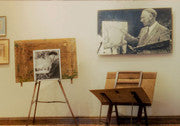
The writer, teacher and human rights activist, Susan Sontag (1933-2004) wrote in her essay Regarding the Pain of Others (2003) that “remembering is an ethical act” and ponders whether the moral obligation of acknowledging others’ suffering, can be facilitated through the witnessing thereof. When art evokes sympathy in a viewer, it often succeeds in directing attention to social and political issues and, above all, reminds us of our shared humanity. Poignant artworks by Käthe Kollwitz, Pablo Picasso, Irma Stern, Maggie Laubser and Marianne Podlashuc that achieve something of this, can be viewed in the La Motte Museum as part of the current exhibition, Celebrating the Love of Art – a personal selection by Hanneli Rupert-Koegelenberg.
The German artist, Käthe Kollwitz (1867-1945) was known for her dedication to portraying the hardships of the working class and her rendering of the grief and harrowing experiences of wars in the first decades of the twentieth century. Kollwitz adopted printmaking as her primary medium and harnessed the graphic and expressive powers of the medium to present the public with an honest look at the consequences of war. Kollwitz was also a skilled sculpturer, creating several memorials that explored her enduring anti-war themes in three dimensions and embodied a deep empathy with human suffering. In Celebrating the Love of Art these sentiments are especially evident in the etching, Woman with Dead Child (1903) and the bronze sculpture, Pieta (1937-38). The Pieta was upscaled and installed in the Neue Wache in Berlin in 1993 as a World War II Memorial, becoming an internationally recognised symbol of compassion.
Similarly, the artwork Mother and Child with Shawl (1966) by Pablo Picasso (1881-1973) is considered one of the best examples of how Picasso elicited emotion through an artwork. This lithographic print based on a 1903-painting from Picasso’s Blue Period, depicts sadness and dismay. The viewer cannot help to empathise with the sorrow in the mother’s eyes, and the pale, cold-looking faces of both mother and child. Picasso’s mastery of creating work that is both upsetting but also sincere, is highlighted by his later world-renowned painting, Guernica (1937) which has been lauded as one of the most powerful anti-war paintings in the history of humanity.
Recognition of a fellow person’s distress is also palpable in a special addition to Celebrating the Love of Art, namely The Eternal Child (1916) by Irma Stern (1894-1966). The painting depicts a young girl wearing a red patterned dress with a white collar and bow. She sits on the edge of her chair with a bunch of wildflowers clasped on her lap, her features, typical of the malnourished children during wartime Germany. Symbolism was added through the life-giving meaning of the flowers within the constraints of war, implied by frame of the chair which metaphorically suggests the restricted natural development of the child. Stern encountered the girl on a tram and felt compelled to draw her to express the misery that war inflicts on all lives.
Closer to home regarding subject matter, the exhibition also presents paintings by Maggie Laubser (1886-1973) who was known for the care and respect with which se depicted her fellow South-Africans. Upon her return to South Africa from the cosmopolitan circles of Berlin in the 1920s, she created a series of portraits of black and coloured women, likely women who worked on the farm, like Portrait of a Coloured Girl (1930) and Volkshuisies (1930). Laubser also painted portrait studies of Indian and Cape-Malay fishermen with the same dignity and consideration given to her sitters.
Finally, one of the most striking examples of empathy through art is seen in the painting Three Boys (1960) by Marianne Podlashuc (1932-2004). Podlashuc was born in Holland in 1932 and lived through the Nazi occupation of the Netherlands during World War II. This experience had a profound impact on her as a compassionate human being, and as an artist whose work would echo a deep awareness of social disparities. This consciousness is particularly reflected in her South African work of the 1950s and 1960s where the stylised image serves as a powerful manifestation of Podlashuc’s response to the realities of less privileged local communities. Three Boys became a widely recognised artwork after appearing as cover illustration for Alan Paton’s iconic work of South African literature, Cry the Beloved Country.
Featured image: Pablo Picasso. Mother and Child with Shawl, 1966. Lithograph. Collection Hanneli Rupert-Koegelenberg











